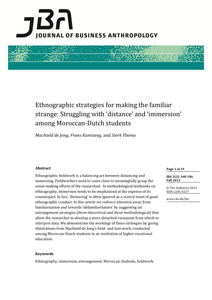The recreational use of nitrous oxide (N2O; laughing gas) has largely expanded in recent years. Although incidental use of nitrous oxide hardly causes any health damage, problematic or heavy use of nitrous oxide can lead to serious adverse effects. Amsterdam care centres noticed that Moroccan–Dutch young adults reported neurological symptoms, including severe paralysis, as a result of problematic nitrous oxide use. In this qualitative exploratory study, thirteen young adult Moroccan–Dutch excessive nitrous oxide users were interviewed. The determinants of problematic nitrous oxide use in this ethnic group are discussed, including their low treatment demand with respect to nitrous oxide abuse related medical–psychological problems. Motives for using nitrous oxide are to relieve boredom, to seek out relaxation with friends and to suppress psychosocial stress and negative thoughts. Other motives are depression, discrimination and conflict with friends or parents. The taboo culture surrounding substance use—mistrust, shame and macho culture—frustrates timely medical/psychological treatment of Moroccan–Dutch problematic nitrous oxide users. It is recommended to use influencers in media campaigns with the aim to decrease the risks of heavy nitrous oxide use and improve treatment access. Outreach youth workers can also play an important role in motivating socially isolated users to seek medical and or psychological help.
DOCUMENT

Social work in the Netherlands is attracting an increasing number of Turkish and Moroccan Dutch professionals, mostly second-generation migrant women from a Muslim background. Inspired by Amartya Sen’s capability approach, this article presents the findings of a qualitative content analysis of 40 interviews with professionals by peers from the same background. The question is, what kind of professionals do these newly started social workers desire to be and what hindrances do they encounter? The professionals challenge the dominance of Western beliefs and values. This becomes tangible in their desires and constraints and especially in the process of choice.
DOCUMENT
Ethnographic fieldwork is a balancing act between distancing and immersing. Fieldworkers need to come close to meaningfully grasp the sense-making efforts of the researched. In methodological textbooks on ethnography, immersion tends to be emphasized at the expense of its counterpart. In fact, ‘distancing’ is often ignored as a central tenet of good ethnographic conduct. In this article we redirect attention away from familiarization and towards ‘defamiliarization’ by suggesting six estrangement strategies (three theoretical and three methodological) that allow the researcher to develop a more detached viewpoint from which to interpret data. We demonstrate the workings of these strategies by giving illustrations from Machteld de Jong’s field- and text-work, conducted among Moroccan-Dutch students in an institution of higher vocational education.
DOCUMENT
